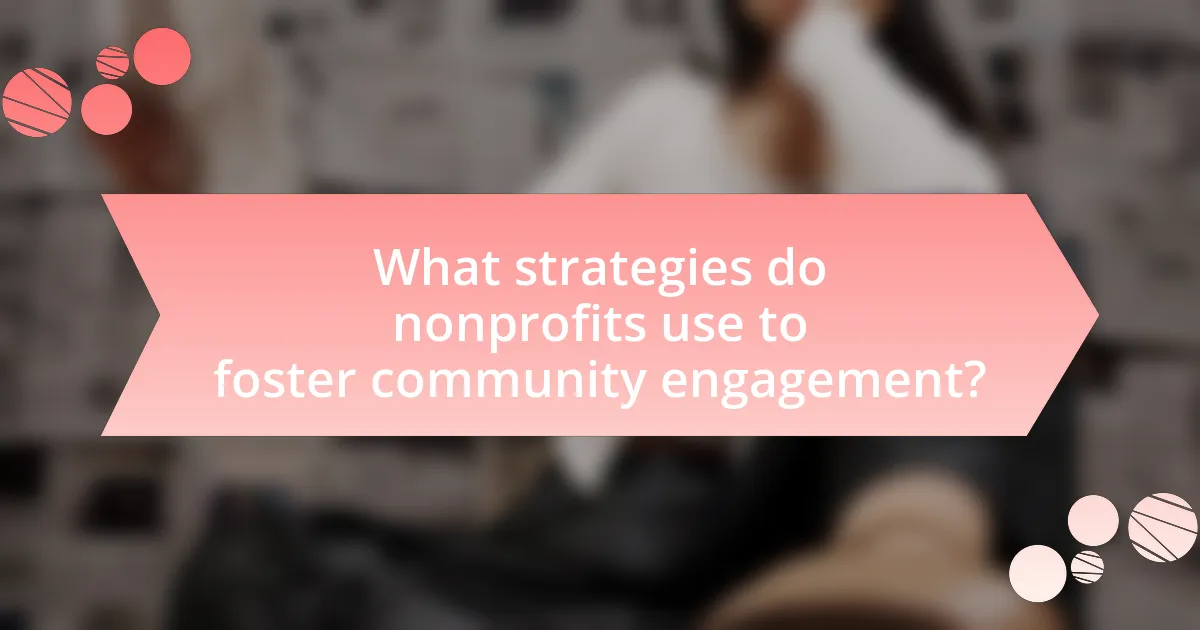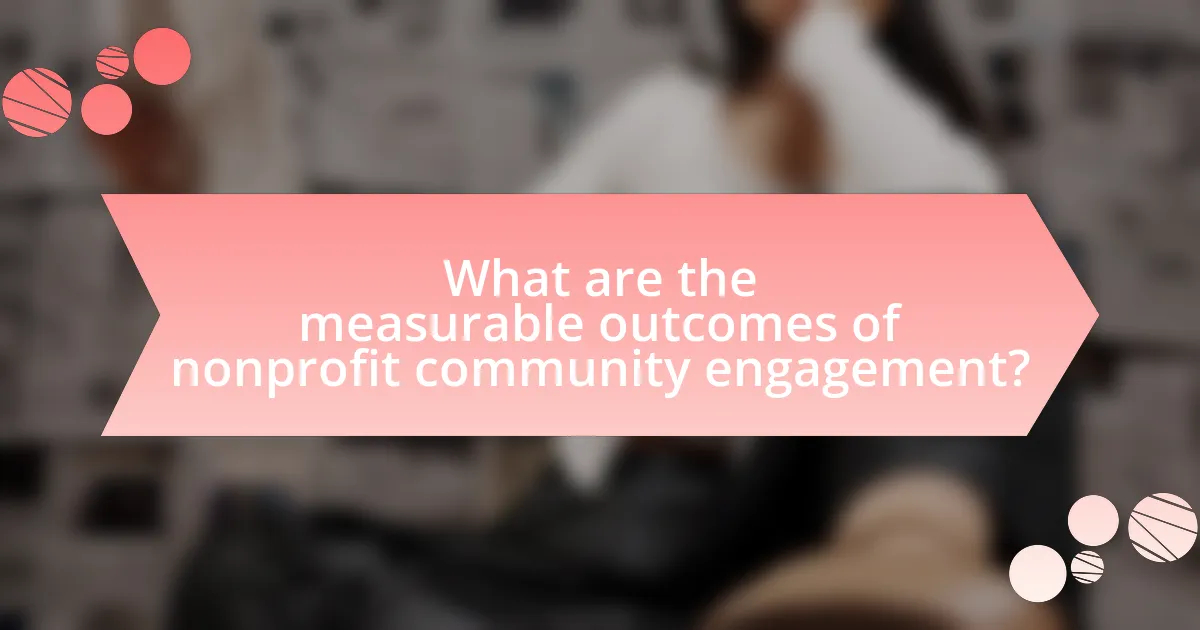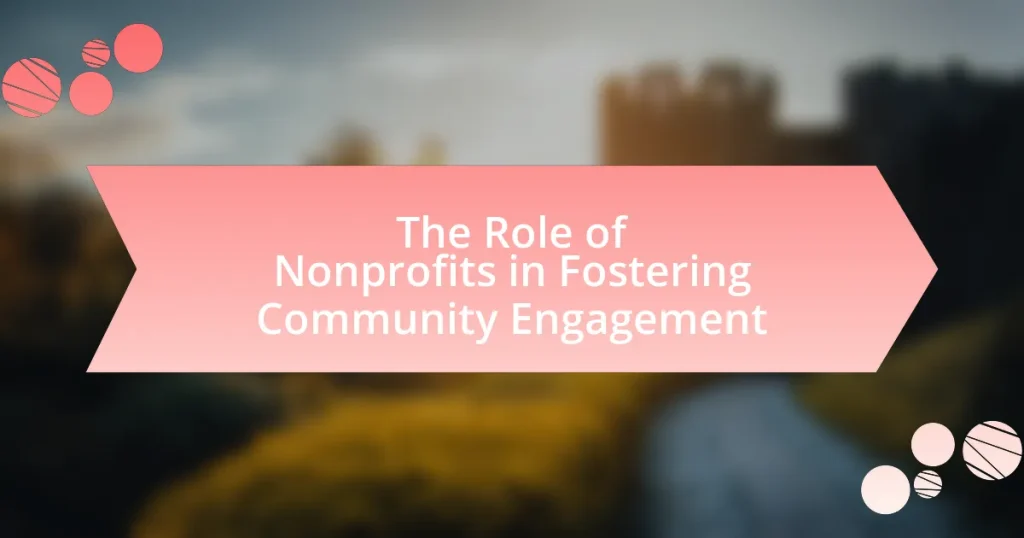Nonprofits play a vital role in fostering community engagement by mobilizing resources, facilitating volunteer opportunities, and creating platforms for dialogue. They contribute to community development by addressing social issues and providing essential services, which enhances the quality of life for residents. The article explores specific programs implemented by nonprofits, methods for identifying community needs, and the importance of community engagement for nonprofit effectiveness and sustainability. It also discusses strategies for fostering engagement, the role of volunteers, challenges faced, and best practices for ensuring inclusivity and gathering feedback to improve engagement efforts.

What is the role of nonprofits in fostering community engagement?
Nonprofits play a crucial role in fostering community engagement by mobilizing resources, facilitating volunteer opportunities, and creating platforms for community dialogue. They serve as intermediaries that connect individuals with local needs, encouraging participation in civic activities and social initiatives. For instance, according to a report by the National Council of Nonprofits, nonprofits engage over 63 million Americans in volunteer work annually, which strengthens community ties and enhances social cohesion. Additionally, nonprofits often address specific community issues, such as education, health, and environmental sustainability, thereby empowering residents to take an active role in shaping their community’s future.
How do nonprofits contribute to community development?
Nonprofits contribute to community development by addressing social issues, providing essential services, and fostering civic engagement. They often fill gaps in public services, such as education, healthcare, and housing, which directly enhances the quality of life for community members. For instance, according to the National Council of Nonprofits, nonprofits employ over 10% of the U.S. workforce and generate significant economic activity, which supports local economies. Additionally, nonprofits engage residents in decision-making processes, promoting community involvement and empowerment, as evidenced by studies showing that communities with active nonprofit organizations report higher levels of civic participation and social cohesion.
What specific programs do nonprofits implement to engage communities?
Nonprofits implement various specific programs to engage communities, including community service initiatives, educational workshops, and health outreach programs. Community service initiatives often involve volunteer opportunities that encourage local residents to participate in projects that improve their neighborhoods, such as clean-up drives or food distribution events. Educational workshops provide training and resources on topics like financial literacy, job skills, or health awareness, fostering personal development and community knowledge. Health outreach programs focus on providing essential health services, screenings, and education to underserved populations, thereby promoting overall community well-being. These programs are designed to build relationships, empower individuals, and create a sense of belonging within the community.
How do nonprofits identify community needs and priorities?
Nonprofits identify community needs and priorities through methods such as community assessments, surveys, focus groups, and collaboration with local stakeholders. These approaches enable nonprofits to gather qualitative and quantitative data directly from community members, ensuring that the identified needs reflect the actual concerns and priorities of the population they serve. For instance, a study by the National Council of Nonprofits highlights that engaging with community members through surveys can reveal pressing issues like food insecurity or lack of access to healthcare, which nonprofits can then prioritize in their programming and resource allocation.
Why is community engagement important for nonprofits?
Community engagement is crucial for nonprofits because it fosters trust, enhances program effectiveness, and builds a sense of ownership among community members. Engaging with the community allows nonprofits to understand local needs and tailor their services accordingly, leading to higher participation rates and better outcomes. Research indicates that nonprofits with strong community ties are more likely to achieve their missions; for instance, a study by the Stanford Social Innovation Review found that organizations that actively engage their communities see a 30% increase in volunteer participation and a 25% increase in donations. This demonstrates that community engagement not only strengthens the nonprofit’s impact but also ensures sustainability and relevance within the community.
What impact does community engagement have on nonprofit effectiveness?
Community engagement significantly enhances nonprofit effectiveness by fostering stronger relationships with stakeholders and increasing resource mobilization. Engaged communities are more likely to support nonprofit initiatives through volunteerism, donations, and advocacy, which directly contributes to the organization’s capacity to achieve its mission. Research indicates that nonprofits with high levels of community engagement experience a 30% increase in funding and volunteer participation, as evidenced by a study conducted by the Stanford Social Innovation Review. This correlation underscores the importance of community involvement in driving nonprofit success and sustainability.
How does community engagement enhance nonprofit sustainability?
Community engagement enhances nonprofit sustainability by fostering stronger relationships with stakeholders, which leads to increased support and resources. Engaged communities are more likely to contribute time, money, and advocacy, creating a stable funding base and volunteer pool. For instance, a study by the Stanford Social Innovation Review found that nonprofits with high community engagement levels reported a 30% increase in donations and volunteer participation. This active involvement not only secures financial resources but also builds a loyal supporter network, ensuring long-term viability and impact.

What strategies do nonprofits use to foster community engagement?
Nonprofits employ various strategies to foster community engagement, including outreach programs, volunteer opportunities, and partnerships with local organizations. Outreach programs, such as community workshops and informational sessions, help raise awareness about issues and services, encouraging community participation. Volunteer opportunities allow individuals to contribute their time and skills, creating a sense of ownership and connection to the nonprofit’s mission. Additionally, forming partnerships with local organizations enhances resource sharing and expands the reach of engagement efforts, as evidenced by studies showing that collaborative initiatives often lead to increased community involvement and support for local causes.
How do nonprofits build partnerships with community members?
Nonprofits build partnerships with community members by engaging in collaborative initiatives that address local needs. They often conduct outreach programs to identify community priorities and establish trust through consistent communication. For example, a study by the National Council of Nonprofits highlights that nonprofits that actively involve community members in decision-making processes foster stronger relationships and enhance program effectiveness. This approach not only empowers community members but also ensures that the services provided are relevant and impactful.
What role do volunteers play in nonprofit community engagement efforts?
Volunteers are essential to nonprofit community engagement efforts as they provide manpower, skills, and local knowledge that enhance program effectiveness. Their involvement allows nonprofits to expand outreach, build relationships within the community, and foster a sense of ownership among residents. For instance, a study by the Corporation for National and Community Service found that volunteers contribute an estimated $184 billion annually to the U.S. economy, demonstrating their significant impact on community initiatives. Additionally, volunteers often serve as ambassadors for the nonprofit, helping to raise awareness and mobilize resources, which further strengthens community ties and engagement.
How can nonprofits leverage social media for community engagement?
Nonprofits can leverage social media for community engagement by creating interactive content that encourages participation and dialogue. By utilizing platforms like Facebook, Twitter, and Instagram, nonprofits can share stories, updates, and calls to action that resonate with their audience. For instance, a study by the Pew Research Center found that 69% of adults in the U.S. use social media, making it a vital tool for reaching diverse community members. Engaging posts, live events, and user-generated content can foster a sense of community and encourage supporters to share their experiences, amplifying the nonprofit’s message and reach.
What challenges do nonprofits face in fostering community engagement?
Nonprofits face several challenges in fostering community engagement, including limited resources, lack of awareness, and difficulties in measuring impact. Limited financial and human resources restrict their ability to reach and engage diverse community members effectively. Additionally, many communities may not be aware of the nonprofit’s mission or services, leading to lower participation rates. Furthermore, nonprofits often struggle to quantify their impact, making it challenging to demonstrate value and attract ongoing support. These factors collectively hinder the ability of nonprofits to build strong, engaged communities.
How can nonprofits overcome barriers to community participation?
Nonprofits can overcome barriers to community participation by actively engaging with community members to identify their needs and concerns. This approach fosters trust and encourages participation by ensuring that programs are relevant and accessible. For instance, a study by the Stanford Social Innovation Review found that nonprofits that involve community members in decision-making processes see a 30% increase in participation rates. By implementing strategies such as outreach initiatives, inclusive programming, and collaboration with local leaders, nonprofits can effectively dismantle obstacles to engagement and create a more participatory environment.
What are common misconceptions about nonprofit community engagement?
Common misconceptions about nonprofit community engagement include the belief that it is solely about fundraising and that it only involves volunteers. Many people think nonprofits primarily engage with the community to solicit donations, overlooking the fact that effective engagement also focuses on building relationships, fostering collaboration, and addressing community needs. Additionally, the notion that community engagement is limited to volunteer work ignores the diverse methods nonprofits use, such as advocacy, education, and partnership development, to create meaningful impact. Research indicates that successful community engagement requires a multifaceted approach, integrating various strategies beyond just volunteerism and fundraising.

What are the measurable outcomes of nonprofit community engagement?
Measurable outcomes of nonprofit community engagement include increased volunteer participation, enhanced community awareness, and improved social cohesion. Nonprofits often track the number of volunteers engaged in their programs, which can indicate community interest and investment in local issues. For example, a study by the Corporation for National and Community Service found that communities with higher volunteer rates experience better social ties and community trust. Additionally, nonprofits may measure changes in community awareness through surveys assessing knowledge of local issues before and after engagement initiatives. Improved social cohesion can be quantified through metrics such as participation in community events and the formation of new social networks, demonstrating the impact of nonprofit efforts on community dynamics.
How can nonprofits assess the effectiveness of their engagement strategies?
Nonprofits can assess the effectiveness of their engagement strategies by utilizing metrics such as participant feedback, engagement levels, and outcome measurements. For instance, collecting surveys from participants can provide direct insights into their experiences and satisfaction, while tracking attendance and participation rates can indicate the level of community involvement. Additionally, analyzing the impact of engagement activities on community outcomes, such as increased volunteerism or improved local conditions, offers concrete evidence of effectiveness. Research shows that organizations employing these assessment methods can better understand their impact and refine their strategies accordingly, leading to enhanced community engagement.
What metrics are used to evaluate community engagement success?
Metrics used to evaluate community engagement success include participation rates, feedback surveys, social media interactions, and volunteer hours. Participation rates measure the number of individuals involved in community activities, indicating the level of interest and engagement. Feedback surveys assess community members’ satisfaction and perceptions, providing qualitative insights into the effectiveness of engagement efforts. Social media interactions, such as likes, shares, and comments, reflect the online engagement and reach of community initiatives. Volunteer hours quantify the time contributed by community members, showcasing their commitment and involvement in nonprofit activities. These metrics collectively provide a comprehensive view of community engagement success.
How do success stories from community engagement influence future initiatives?
Success stories from community engagement significantly influence future initiatives by providing tangible examples of effective strategies and outcomes. These narratives serve as motivational tools, demonstrating the potential impact of community involvement and fostering a sense of shared purpose among stakeholders. For instance, a successful community garden project can inspire similar initiatives by showcasing improved local food access and community cohesion. Research indicates that organizations that share success stories are more likely to attract funding and volunteer support, as evidenced by a study from the Stanford Social Innovation Review, which found that 70% of nonprofits reported increased engagement after sharing impactful stories. This evidence underscores the importance of leveraging success stories to guide and enhance future community engagement efforts.
What best practices can nonprofits adopt for effective community engagement?
Nonprofits can adopt several best practices for effective community engagement, including building strong relationships, actively listening to community needs, and fostering inclusive participation. Establishing partnerships with local organizations enhances trust and collaboration, while listening to community feedback ensures that programs align with actual needs. Additionally, creating opportunities for diverse community members to participate in decision-making processes promotes inclusivity and empowers individuals. Research indicates that organizations employing these strategies see increased community involvement and support, as evidenced by a study from the Stanford Social Innovation Review, which highlights the correlation between community engagement practices and nonprofit effectiveness.
How can nonprofits ensure inclusivity in their engagement efforts?
Nonprofits can ensure inclusivity in their engagement efforts by actively involving diverse community members in decision-making processes. This approach fosters a sense of belonging and ensures that the needs of various groups are represented. Research indicates that organizations that prioritize inclusive practices, such as conducting surveys and focus groups with underrepresented populations, see increased participation and satisfaction among community members. For instance, a study by the Stanford Social Innovation Review highlights that nonprofits that engage with diverse stakeholders are more effective in addressing community needs and achieving their missions.
What role does feedback play in improving community engagement strategies?
Feedback is essential in improving community engagement strategies as it provides insights into the needs and preferences of community members. By actively soliciting and analyzing feedback, nonprofits can identify gaps in their engagement efforts, tailor their programs to better serve the community, and enhance overall participation. For instance, a study by the Stanford Social Innovation Review found that organizations that incorporate community feedback into their planning processes see a 30% increase in engagement levels. This demonstrates that feedback not only informs strategy adjustments but also fosters a sense of ownership among community members, leading to more effective and sustainable engagement initiatives.
